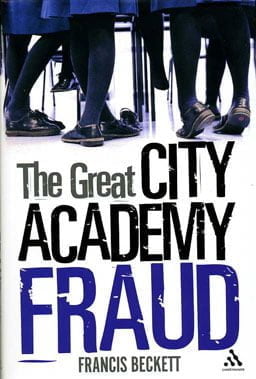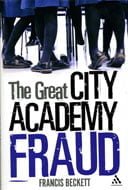A recently published
book by Francis Beckett, The Great City Academy Fraud, is a clear exposé
of the City Academies programme of the New
Labour government. Launched by David Blunkett in March 2000, the Academies
programme is both an attack on state education and, in educational terms, a
disaster. The programme is also an example of the spin and deceit methods that
are the hallmark of New Labour.
 Introduced by Blunkett
Introduced by Blunkett
under the guise of helping inner city deprived children with the paternalistic
and benevolent aid of private capital, Academies have distorted and disrupted
educational planning in the areas where they have been built. They have
involved the wholesale handing over of money and the control of education to a collection
of evangelical Christians and rich businessmen.
A quick glance at the
history of the Academies programme reads like a story of wanton waste, combined
with an aggressive policy to disrupt and undermine state education.
The first remarkable
feature of the Academies programme is that is a direct development of the City
Technology Colleges (CTCs), introduced by the Tory Education Minister Kenneth
Baker in 1986. This scheme developed twenty colleges with sponsors from
businesses, the churches and educational trusts. The schools then set up would
be owned and run by these sponsors. The Major government later abandoned the
CTC programme as an educational failure. It is therefore the more surprising
that it is this same model the Academies have been built on. There are,
however, some differences.
The Tories demanded that
the sponsors, soon to own the new schools, should put up £8 million each for
the pleasure of being given a £30 million school to own and control, along with
continued funding for staff and resources from the government. New Labour has been more generous, only
asking for £2 million, clearly trying to outdo the Tories in terms of their
generosity to the business community. Equally, while CTCs had governing boards
included teaching staff and parent representation – although always a small
minority – academies have none of these ‘restrictions’. The governing boards of
these schools are wholly determined by the new owners, who can appoint who they
like to run the schools, ignoring the educational experience of teachers, the
representation of parents and any planning and coordination input from local
education authorities in each local area.
Part of the government’s
presentation of the Academies programme is that it supposedly will enable
private money to help fund education, and by implication increase the overall
pot of funds available to education. Leaving aside the whole issue that if more
money is needed it could be raised by taxing the rich, the idea that helpful
money is coming from other sources is nothing but spin. Firstly, the £2 million
is in reality only £1.2 million, as these companies claim tax relief. Secondly,
most donators in 2007 have yet to pay the money. Thirdly, the type of payments
that have been made have largely been ‘in kind’, through such machinations as
lending the schools the company’s directors at a large consultancy fees, or
supplying goods to the school which the company itself makes and which are then
taken off the £1.2 million bill they are supposed to pay.
In reality, rather than
money coming from business, the reverse is the case; large chunks of the
government’s education budget is being given away to these privatised schools,
diverting funds that could go to developing all the other schools in the local
area, and who continue to be starved of adequate funding to meet the
educational needs of their students.
An example of this can
be illustrated by comparing the capital cost for building a state-sector
secondary school for 11-18 year olds – between £15 and £20 million. By
contrast, City Academies are costing an average of £35 million, with the one at
Bexley estimated to exceed £50 million. Precise costs are likely to be more,
but are conveniently hidden, as the government refuses to release the details
under the incredulous claim of ‘commerical confidentiality’! However, recent
leaks to a local paper in Blackburn has indicated that the new Darwen Academy,
currently being built, is now estimated to cost around £49 million, some £15
million over the original budget. And figures published by the Sunday Telegraph in August 2007 indicate
that the 106 current Academies, which make up just 1% of schools, received 8.2%
of the capital school building project for schools in England and Wales.
Beckett also points out
that, "A pupil’s place at an Academy cost £21,000, almost twice as much as the
cost of a pupil place at a state school, which is just under £14,000." At the
same time, while local authority schools have restricted staffing numbers and
resource budgets, Academies have been allowed free-rein to claim from the
government’s education budget, enabling them to boost staffing and year-by-year
resources. However, evidence suggests that most of the additional staffing
costs have gone on excessive pay for the senior executives of these new
schools, and a higher proportion of classroom teachers have been placed on
temporary contracts, undermining pay and pensions for ordinary teachers.
The example of the
Bexley Academy illustrates the type of individual who now owns these schools. Bexley
is owned by millionaire property developer, Sir David Garrard, who would have
been Lord Garrard but for the cash for honours saga – he was personally
recommended by Tony Blair for a peerage, but he later withdrew from the list as
the honours crisis broke. Garrard gave a
secret loan to the Labour Party of £2.3 million in 2005. But more significantly,
he also funds the call centre at Conservative Central Office, which played a
key role in the last general election hoping to secure a Conservative win. Garrard
owns the company Minerva which, as Beckett points out, was given the go ahead
by John Prescott, to build "the controversial Park Place shopping centre
in Croydon, which will become one of the country’s ten biggest shopping
malls". Experience in education, zero. Sleazy influence with New Labour, probable!
Another main character
is Sir Peter Vardy, who so far owns two Academies, but wants to own a whole lot
more. He is a fundamentalist Christian and a secondhand car salesman who made
it big, and now has some 98 dealerships with 6,000 employees. He is another
close friend of Tony Blair and wants to teach creationism in his academy
schools. It will not be surprising if, following the example of creationist
controlled schools in the United States, that ‘unsuitable’ and irreligious
books will be banned – although not openly burned. Reports have already leaked
out that a school student at one of Vardy’s Academies was disciplined for not
carrying the Bible in their hands at designated times.
If the scandal of the
financing and privatisation of education were not enough, in educational terms
the Academies are also proving to be a failure. The point should have been
rather obvious, that if you hand over the control of education to people who
have no knowledge, skill or experience of education, they are not likely to do
the job of running schools very well. Would you hire a carpenter to fix your
gas central heating? Yet this is precisely what has occurred.
There has been a whole
string of statistics and information produced that throws light on the doubtful
educational practices in these academies. Far from developing cutting-edge
education, evidence suggests that under the direction of the new owners, a
1950’s style of teaching and learning is re-emerging, with electronic
whiteboards merely replacing the blackboard as a surface to write and copy notes
from.
One source of evidence indicating
the extent of the poor quality of education in the Academies is the UNISON
booklet, entitled Academies Called to Account. Quoted from by Beckett,
it provides evidence using the government’s own quality measures. The UNISON
report indicates that in the 2004 GCSE tables, five of the eleven Academies
showed no improvement, and one had the second worst results in England. There is
also additional evidence suggesting that several of the Academies would have
failed their school inspections for poor management and teaching quality had it
not been for ‘behind the scenes’ pressure that they should be seen to be
successful. Nevertheless, one academy was so bad that it was failed.
If these figures of the Academies’
performance are considered alongside the huge funding and resources that these
schools have received, the performance measured by OFSTED stands out even more
starkly. The question should be asked: How much more could have been done by
state sector schools and teachers if they had been given this money and
resources? Many of the state sector schools are currently doing a fantastic
job, with far less funding and in more difficult circumstances than the richly
resourced academies.
However, when using
these figures on ‘performance’ we should be clear that this data only
illustrates failure based on the government’s own criteria. Educationalists have, and
continue to, dispute these false measures of educational quality which attempt
to incorporate competition and a race for results; educationalists and teachers
are convinced that they are detrimental to the educational development of
children. Nevertheless, given the millions of pounds poured into these Academies,
the government is faced with an end result that is an indictment on their own
terms.
Overall Beckett’s book
performs a great agitational role in exposing the sleaze, corruption and
educational failure of the Academies programme. The book has a series of case
studies, a large number of facts, and interesting interviews with a range of
people involved with Academies, including revealing quotes from those currently
running some of the schools. The book, however, is far less effective in terms
of proposing a way forward and in theorising the reasons for the
development of this New Labour
policy. Perhaps this is to be expected, as Beckett is primarily an
investigative journalist; the book fits neatly into this type of reporting and is
worth reading for this purpose. However, if you cannot afford to purchase the
book (it retails for £15) or get it on loan from your local library, a
significant amount of the data in the book can also be found online at the NUT
website under campaigns/Academies in
two documents titled: Academies: Looking beyond the Spin and Academies Briefing.
Equally, a range of articles and information on local campaigns can be found on
the Anti-Academies Alliance website: www.antiacademies.org.uk
Moving beyond the
scandalous facts, as socialists, trade unionists and political activists we
also need to evaluate why these policies were developed by New Labour, and then actively campaign to change the policy.
On the surface, the
story of the City Academies reads like a sit-com of incompetent government
ministers who haven’t a clue what they are doing. Yet, this tragedy is
underlined by a more serious intention: the policy is an attack on state
education, and one that distorts the educational opportunities for children in
the local areas where they are built. It shifts
government money towards the privileged, but inefficient, Academy schools. But
the policy is also the spearhead of New
Labour‘s broader privatisation of state education; the Academies programme
is the equivalent to the privatisation policies in the health service and local
government services, and as such presents a major threat to state education.
It is of little surprise
that the Tories have dumped the policy of creating new selective Grammar
schools and announced their support for the Academies programme. In spite of
the initial hostile responses to the Tory leadership’s proposals from its own
ranks, the anxieties of these less far-sighted Tories are misplaced; Grammar
schools will continue, and will even be allowed to expand. The major drive to
create a new selective system, however, will come through the Academies
programme.
There are only 164
state-funded Grammar schools in England and Wales; there already exist over 100
Academies, and Ed Balls has recently announced proposals to create a further
400. The real future for selective education lies with the creation of a new
national tripartite education system based upon independent Academies, each
deciding their own curriculum and student admissions policy.
One Academy will be
developed to be ‘academic’, another ‘vocational’, and the remaining, well let’s
call them ‘the rest’, will consist of the children that the academic and
vocational Academies refuse to admit, or exclude as unacceptable. The first
signs of this development are already present where two fee-paying schools,
William Hulme’s Grammar School in Manchester and Belvedere Girls School in
Liverpool, have been accepted to run Academies stating that they will focus on
‘academic’ students. At the same time student exclusion rates from existing
Academies are running at ten times the national average, with evidence of many
more going unrecorded. Other Academies are being groomed as vocational centres.
All this is possible because Academies do not have to deliver the National
Curriculum and are free to design their own curriculum, with the governing body
of each Academy appointed by the sponsor and unaccountable to the local
community, parents or teachers.
Currently Academies are
allowed to select 10% of their pupils, but this is the crest of a larger
molehill. It is implicit in the structure of Academies that the percentage of
students that are selected can be increased. It takes no stretch of the
imagination to see that the creation of more Academies will allow the argument
for greater selection, based on the ‘differences between the academies’. The
spin words will be ‘children’s aptitude’, or ‘choice’, or even the meaningless
term ‘diversity’; but the reality will amount to selection, for it will not be
parents who have the ability to choose, but the admission policies of the
Academies.
The New Labour
ideological vision sees the national state-owned education system done away
with and replaced by this new model of independently run schools based on areas
of specialism -academic, vocational and ‘the rest’. The vision is the outcome
of the broader New Labour ideology that society is best run by the market
mechanism, with government playing a minimum role. However, it is not the
parents or children who are the idealised consumers shopping in the market
place; rather, the market mechanism of choice is operating to pick and choose
which child is to be given an academic or vocational education. It is the
Academies who will shop around for the choicest children.
Marxists will understand
that this process is a reassertion of control by capital over the reproduction
of labour. It works its way through into the policy of New Labour by
their attachment and relationship to the idea of globalisation and the value of
the market mechanism. New Labour can
be seen as the mutated child of the Social Democratic right wing of the labour
movement, and has consequently inherited the pragmatism of Social Democracy of
accepting capitalism ‘as it is’. The rationale of Blair and Brown is clear: if
Britain is to make its way in the world, then it needs to adapt to the
requirements of capital. Although the actual words they use is that "Britain
needs to modernise". Brown expressed these sentiments in his 2006 Foreword to
the re-publication of Anthony Crosland’s*, The
Future of Socialism. After praising Crosland, he argues that the world has
now changed and that: "Crosland was dealing with a sheltered economy in a
pre-global age of national economies… Today globalisation is defined by
cross-border flows of capital and the global sourcing of goods and services." The
conclusion Brown draws is that Britain needs to develop a flexible and
well-trained labour force. which New Labour engvisages as being created by an education system premised
on independent Academies.
Part and parcel of the
change in the delivery and system of education is also an attack on the
conditions of employment of teachers and school staff. All Academies are
allowed to set their own pay, conditions and working time arrangements,
regardless of national union agreements. Again, by making each Academy a
separate institution, the government claims each as an individual employer. The
result of this will be similar to the destruction of the Silver Book conditions
in Further Education employment. Under the Academy system, the School’s Burgundy Book conditions of employment will disappear.
Currently, teachers
transferred from the schools closed when the Academies are opened are covered
under employment legislation and have their previous pay and conditions
protected. However, these members of staff are a minority, and the legislation
does not cover any new staff or replacement for these staff when they leave,
nor does it cover any Academy that was created without a specific school
closing. The independent Academies can change the conditions of service of
teachers, including pay scales and pension rights whenever they like. Current
experience is not looking good, with a larger than average number of staff on
short-term 6-month contracts, with corresponding loss of security of employment
and sickness benefits. Equally, there is only union recognition in some of the
Academies, with strong evidence of an anti-union stance generally by Academies’
governing bodies.
The extension of the
Academies programme will effectively be an attack by the government on
nationally negotiated union agreements, creating a large number of schools
operating under conditions which ignore agreed pay and conditions. As the
number of Academies grows, the ability of teachers to avoid employment in
Academies will diminish, and correspondingly increase the power of the
Academies’ governing boards. Teachers are therefore facing a potentially bleak
future of struggles to maintain their conditions of employment.
The NUT is rightly at
the forefront of opposition against the Academies programme, alongside many
local groups which have sprung up in opposition to the creation of Academies,
to the closure of existing community schools or to the diverting of funds away
from existing schools in order to build the plush Academies.
However, the shape of
the battle against the Academies programme needs to involve a range of
strategies, including involvement in local struggles to stop the creation of
Academies, the building of union membership within individual Academies and a
wider political struggle to turn the Labour Party back to its roots and wrest
control and power away from the neo-conservative infiltrators of New Labour who currently control the
leadership of the Labour Party.
Within the broader
labour movement we need to refocus on and campaign for an alternative education
policy. We need to demand a well-resourced, comprehensive, state-funded
education system that includes democratic participation and control by
teachers, school staff, parents, students and local education authorities in
the running of all schools.
* Anthony
Crosland was one of the main Social Democratic thinkers in the Labour Party
between the 1950s and 1970s. Along with other right wing thinkers such as Hugh
Dalton and earlier, Evan Durbin, he attempted to turn the Labour Party further
away from a socialist policy and programme than it already was at that time.






